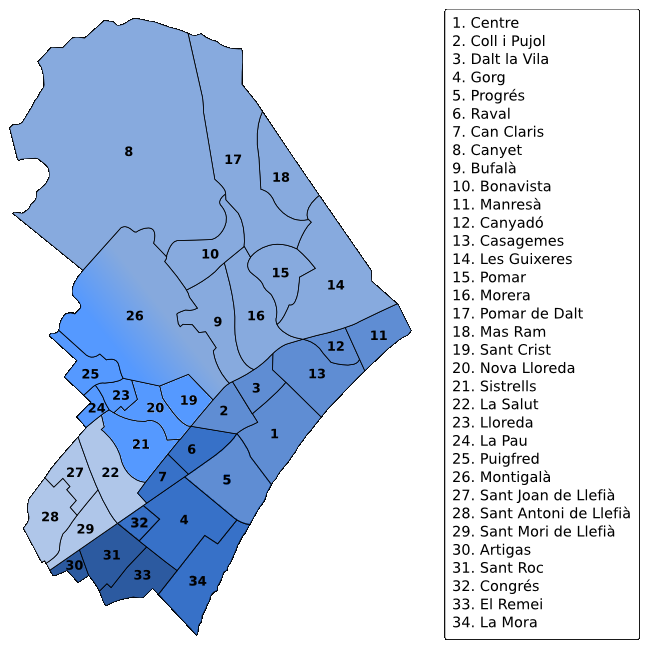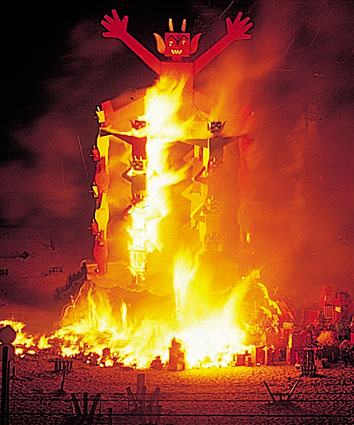|
Sant Roc (Barcelona Metro)
Sant Roc is a Barcelona Metro station in Sant Roc, a neighbourhood of the municipality of Badalona, in the metropolitan area of Barcelona. It's served by L2 and since 2007, by Trambesòs Trambesòs () is a tram– light rail system in the Spanish autonomous community of Catalonia that links the Barcelona district of Sant Martí with Badalona and Sant Adrià de Besòs. Its name comes from the union of the words "tram", an abbre ... route T5. It was opened in 1985 as part of L4 and moved to L2 in 2002. It can be accessed from Plaça President Tarradellas and from Carrer Alfons XII. Services See also * List of Barcelona Metro stations External links *Trenscat.com Railway stations in Spain opened in 1985 Barcelona Metro line 2 stations Trambesòs stops Railway stations in Badalona {{Barcelona-metro-stub ... [...More Info...] [...Related Items...] OR: [Wikipedia] [Google] [Baidu] |
Barcelona Metro
The Barcelona Metro (Catalan and Spanish: ) is an extensive network of rapid transit electrified railway lines that run mostly underground in central Barcelona and into the city's suburbs. It is part of the larger public transport system of Barcelona, the capital of Catalonia, Spain, with unified fares under the (ATM) scheme. As of 2014, the network is operated by two separate companies: (TMB) and (FGC). It is made up of 12 lines, combining the lines owned by the two companies. Two lines, L9 and L10, are being built at present, with both lines having different sections of each opened between 2009 and 2018. They are due to be fully completed in 2026. Three lines on the network have opened as automatic train operation/driverless vehicle systems since 2009: Line 11, Line 9 and Line 10, in chronological order. The network length is , with 183 stations, as of November 2021. History The first rapid transit railway service in Barcelona was founded in 1863 by the pri ... [...More Info...] [...Related Items...] OR: [Wikipedia] [Google] [Baidu] |
Sant Roc
Sant Roc (Catalan name; Spanish: ''San Roque'') is a neighbourhood of Badalona, in the metropolitan area of Barcelona (Catalonia, Spain). In 1958 the Badalona city council planned construction on the site, under the name of Barrio del Regadío. It was urbanised beginning in December 1962 and originally inhabited by people resettled from slums in the Barcelona area, after damages caused by major floods. Still nowadays it has an important Roma presence. The Francoist housing organisation Obra Sindical del Hogar y Arquitectura was responsible for most of the construction in Sant Roc, mostly made up of tower blocks.http://xtec.cat/~jjover/ Public transport The Barcelona Metro station '' Sant Roc'' is located in the neighborhood. It is served by L2 and also by Trambesòs Trambesòs () is a tram– light rail system in the Spanish autonomous community of Catalonia that links the Barcelona district of Sant Martí with Badalona and Sant Adrià de Besòs. Its name comes from the ... [...More Info...] [...Related Items...] OR: [Wikipedia] [Google] [Baidu] |
Badalona
Badalona (, , , ) is a Municipalities of Spain, municipality to the immediate north east of Barcelona in Catalonia, Spain. It is located on the left bank of the Besòs River and on the Mediterranean Sea, in the Barcelona metropolitan area. By population, it is the third largest city in Catalonia and the Ranked lists of Spanish municipalities, twenty-third in Spain. It became a city in 1897. Names The name Badalona comes from ancient Iberian word ''Baitolo'' according to the legend of several bronze coins of the end of the 2nd century BC found in the city. This word was the origin of the Latin name ''Baetulo'' that was as the Romans named the new city they founded off the coast of present Badalona. The oldest mention of the name Baetulo is from ''De Chorographia'' of Pomponius Mela (43–44 AD), who use the same name for the Besòs (river), Besòs river (named ''Bissaucio'' during the Middle Ages). Following the Roman era, during the High Middle Ages the name ''Baetulo'' evolved t ... [...More Info...] [...Related Items...] OR: [Wikipedia] [Google] [Baidu] |
Metropolitan Area Of Barcelona
The Barcelona urban area is an urban area in Catalonia (Spain) centered on the city of Barcelona and located less than 100 km south of the border with France. With a population of over 5 million, it is the most populous urban area on the Mediterranean coast, and one of the largest in Europe. Overview The urban area – the core of the metropolitan area – of Barcelona has a population of 4,604,000, being the fifth-most populous urban area in the European Union after Paris, the Ruhr area, Madrid and Milan. The Larger Urban Zone has a population of 4,440,629 according to Eurostat. As stated by the Department of Economic and Social Affairs of United Nations, the metropolitan area of Barcelona has a population of 5,083,000, according to the Organisation for Economic Co-operation and Development it has a population of 4,900,000 and according to the Eurostat it has a population of 5,375,774. According to ''Idescat'' it has a population of 5,029,181, [...More Info...] [...Related Items...] OR: [Wikipedia] [Google] [Baidu] |
Barcelona Metro Line 2
Barcelona ( , , ) is a city on the coast of northeastern Spain. It is the capital and largest city of the autonomous community of Catalonia, as well as the second most populous municipality of Spain. With a population of 1.6 million within city limits,Barcelona: Población por municipios y sexo – Instituto Nacional de Estadística. (National Statistics Institute) its urban area extends to numerous neighbouring municipalities within the and is home to around 4.8 million people, making it the [...More Info...] [...Related Items...] OR: [Wikipedia] [Google] [Baidu] |
Trambesòs
Trambesòs () is a tram– light rail system in the Spanish autonomous community of Catalonia that links the Barcelona district of Sant Martí with Badalona and Sant Adrià de Besòs. Its name comes from the union of the words "tram", an abbreviation of the Catalan word for "tram" (''tramvia''), and "Besòs", the name of an area in the north of the Barcelonès region dominated by the Besòs River. The first section of Trambesòs was opened on 8 May 2004 as part of route T4 and since its opening it has undergone several extensions, the last of which took place on 15 June 2008 with the creation of route T6 between Sant Adrià de Besòs railway station and Gorg metro station in Badalona. Trambesòs is operated by TRAM. It complements the Trambaix that runs to the south-west of the city. Both networks will be interconnected through Avinguda Diagonal in the next construction phase. System overview The system comprises 27 stops and has a total length of whereby three different rou ... [...More Info...] [...Related Items...] OR: [Wikipedia] [Google] [Baidu] |
Trambesòs Line T5
Trambesòs () is a tram– light rail system in the Spanish autonomous community of Catalonia that links the Barcelona district of Sant Martí with Badalona and Sant Adrià de Besòs. Its name comes from the union of the words "tram", an abbreviation of the Catalan word for "tram" (''tramvia''), and "Besòs", the name of an area in the north of the Barcelonès region dominated by the Besòs (river), Besòs River. The first section of Trambesòs was opened on 8 May 2004 as part of route T4 and since its opening it has undergone several extensions, the last of which took place on 15 June 2008 with the creation of route T6 between Sant Adrià de Besòs railway station and Gorg station, Gorg metro station in Badalona. Trambesòs is operated by TRAM (company), TRAM. It complements the Trambaix that runs to the south-west of the city. Both networks will be interconnected through Avinguda Diagonal in the next construction phase. System overview The system comprises 27 stops and ... [...More Info...] [...Related Items...] OR: [Wikipedia] [Google] [Baidu] |
Barcelona Metro Line 4
Line 4, also known as Trinitat Nova – La Pau, usually called "línia groga" (yellow line), is a line in the Barcelona Metro network operated by TMB, and part of the ATM fare-integrated transport network. It serves the northern districts of the city, and it is being extended to the new major metro and rail stations Estació de la Sagrera and Sagrera-Meridiana. Overview Opened to the public in 1973, it serves the northern half of Barcelona using part of the infrastructure of Barcelona's first metro line the '' Gran Metro de Barcelona'', covering a wide C-shaped area stretching from La Pau (in la Verneda) to Trinitat Nova, where it is linked with the recent L11. The 16.7 kilometres that make up the whole line are underground. Although in 1966 it was planned for line 4 to be a loop line connecting Trinitat Nova and La Pau stations with three intermediate stations, in 1974 the plan was subsequently changed such that it became a C-shaped line of today, with provisions for two ... [...More Info...] [...Related Items...] OR: [Wikipedia] [Google] [Baidu] |
List Of Barcelona Metro Stations
This is a list of stations of the Barcelona Metro system. Lines L1, L2, L3, L4, L5, L9, L10, L11 and the Funicular de Montjuïc are administered by Transports Metropolitans de Barcelona (TMB), the city's transit company. Lines L6, L7, L8 and L12 are in origin commuter train services with extended frequency and integrated into the metro network, numbered as such, and run by the public Ferrocarrils de la Generalitat de Catalunya (FGC), which belongs to the Catalan government or Generalitat de Catalunya. Sorted alphabetically Sorted by line Line 1 * Hospital de Bellvitge * Bellvitge * Avinguda Carrilet ( L8) * Rambla Just Oliveras * Can Serra *Florida * Torrassa ( L9) * Santa Eulàlia * Mercat Nou * Plaça de Sants ( L5) * Hostafrancs * Espanya ( L3, L8) *Rocafort *Urgell * Universitat ( L2) *Catalunya ( L3, L6, L7) * Urquinaona ( L4) *Arc de Triomf *Marina (T4) * Glòries (T4, T5, T6) *Clot ( L2) *Navas *La Sagrera ( L5) * Fabra i Puig *Sant Andreu * Torras i Ba ... [...More Info...] [...Related Items...] OR: [Wikipedia] [Google] [Baidu] |
Railway Stations In Spain Opened In 1985
Rail transport (also known as train transport) is a means of transport that transfers passengers and goods on wheeled vehicles running on rails, which are incorporated in tracks. In contrast to road transport, where the vehicles run on a prepared flat surface, rail vehicles (rolling stock) are directionally guided by the tracks on which they run. Tracks usually consist of steel rails, installed on sleepers (ties) set in ballast, on which the rolling stock, usually fitted with metal wheels, moves. Other variations are also possible, such as "slab track", in which the rails are fastened to a concrete foundation resting on a prepared subsurface. Rolling stock in a rail transport system generally encounters lower frictional resistance than rubber-tyred road vehicles, so passenger and freight cars (carriages and wagons) can be coupled into longer trains. The operation is carried out by a railway company, providing transport between train stations or freight customer facili ... [...More Info...] [...Related Items...] OR: [Wikipedia] [Google] [Baidu] |
Barcelona Metro Line 2 Stations
Barcelona ( , , ) is a city on the coast of northeastern Spain. It is the capital and largest city of the autonomous community of Catalonia, as well as the second most populous municipality of Spain. With a population of 1.6 million within city limits,Barcelona: Población por municipios y sexo – Instituto Nacional de Estadística. (National Statistics Institute) its urban area extends to numerous neighbouring municipalities within the and is home to around 4.8 million people, making it the [...More Info...] [...Related Items...] OR: [Wikipedia] [Google] [Baidu] |





